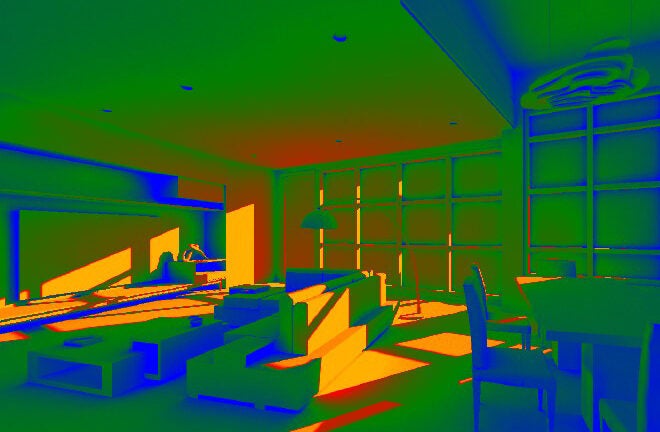
Digital leader in architecture merges virtual reality with big data
Using trend-setting tools, Karen Kensek can predict a building’s attributes before construction
[new_royalslider id=”11″]
Karen Kensek thinks of buildings as living organisms, self-adjusting and self-correcting, as they transmit a constant stream of data about themselves. Unlike most living organisms, however, many of a building’s attributes can be predicted before construction. Kensek, assistant professor at the USC School of Architecture, is a pioneer in these predictions, using computer applications to model a building’s features.
It’s a career that started when she learned programming during her undergraduate days at the Massachusetts Institute of Technology. A summer research project at MIT on buildings and daylight led her to envision the future of digital tools in architecture. She went on to earn a master’s degree in architecture at the University of California, Berkeley, where she then taught in newly developed computer application courses and in computer-aided design (CAD) studios.
Always an early adopter, she ushered in the successor to CAD: a system called building information modeling (BIM), which provides live views of three-dimensional virtual models that are rich with data.
The benefits of BIM
BIM used with analysis software can predict a building’s energy consumption, how structural components will perform, warn of clashes between mechanical systems, estimate costs and oversee a completed building’s maintenance, among other tasks. As a design tool, BIM allows architects to customize a curvy façade, for example, and have the individual components, such as panes of glass and structural steel, adapt digitally to the constraints put upon them. It’s virtual reality meets digital fabrication meets big data.
BIM spans the entire life cycle of a structure and allows architects to ‘run’ the building.
Karen Kensek
“BIM is an integrated database of construction information based on a 3-D model of a building,” Kensek explained. “It spans the entire life cycle of a structure and allows architects to ‘run’ the building. From conceptual design to construction to the operation of the building, BIM has a role. No more looking for rolls of old, crumpled drawings in the basement when you need to find out when filters need to be changed.”
BIM Symposium comes to campus
Kensek has been in the BIM trenches since its inception, not only teaching it to USC students, but bringing professional adherents from around the country to annual summer BIM symposia. On Aug. 22 and 23, she’s hosting her eighth annual BIM Symposium on campus. This year’s two themes are BIM GAP (how to bridge gaps between various BIM tools and in BIM knowledge among contractors, architects, building owners, managers, subcontractors and consultants) and BIM EDGE (who do you call when you need BIM guidance?).
BIM experts from around the United States will gather at USC to enlighten an audience of nearly 200 Southern California architects, contractors, clients and academics.
Previous symposia have focused on using BIM in sustainable design, construction and fabrication, BIM analytics, “extreme” BIM customization and even “practical” BIM.
Another indication of Kensek’s key role in the BIM arena is the fact that she authored two just-published books on the subject. One, simply called Building Information Modeling (Routledge) is designed as a guide for those unfamiliar with BIM. The pocket-sized paperback addresses the role that modeling plays in developing software tools and office processes in the architecture, engineering and construction professions. The book is designed not only as a textbook for classes on digital design and professional development, but also for professionals implementing BIM in their offices.
“It also tells students coming into architecture and engineering schools what they really need to know about BIM before they start classes,” Kensek said.
Building science: a challenging course
Several examples and visuals in the book are from her USC students and from the building science master’s theses she oversees. Kensek teaches Architecture 507 (“Theories of Computer Technology”) and Architecture 526, a professional practice class taught with colleague Michael Hricak. She also is active in the Master of Building Science program.
The Architecture 507 course she teaches for fifth-year and graduate students turns out Trojans who “are very technically hands-on competent in BIM at the end of the course and are poised to be leaders in the field,” Kensek said. “The course is challenging, but when they go to find a job, they’re thankful. They’re very well prepared.”
During the semester, students design a building, creating floor plans, sections and renderings, then figure out foot candles of illumination, do energy studies, wind flow diagrams, and they put the building through sustainable building design programs.
“I tell them you had better love your building because you are going to be working on it forever,” she said.
Advanced research
Her second just-published book, Building Information Modeling in Current and Future Practice (Wiley), was written with USC office mate Douglas Noble, the discipline head for building science and director of the School of Architecture’s Ph.D. program. It’s a more advanced book, with Kensek and Noble editing chapters from international thought leaders who are conducting timely research on BIM. The book includes, among other topics, essays from futurists and experts in BIM analytics, smart buildings, energy modeling in conceptual design and building simulations that can create urban energy districts.
The fact that Kensek and Noble were asked to vet experts in the field confirms their leadership in BIM. Both said that USC Architecture as a whole is also at the forefront of digital design.
“USC Architecture has been doing really well with design computing, and the school has really gotten behind BIM,” Kensek said. “USC jumped into digital design even before I came here in 1991. And recent hires have really added to our design computing expertise.”
Kensek’s work is ever-evolving, moving into research on using BIM to construct high-performance buildings, visual scripting and customization, and leading the school into the next era of digital design.
